Ken Neill, III
Published in Chesapeake Angler
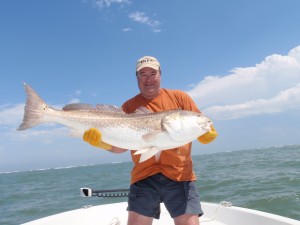 We fish a lot. Our boats are never put away for the winter. It is during the spring that I am often asked things like, “Have you started fishing yet?” or “Is it almost time for the fishing season to start?” Hard-core anglers do not ask these questions nor do those that really know me and the guys that I fish with. We never stop fishing but there is a time when a new fishing season or year starts for us. Our new fishing year does not start on January 1. We are still just fishing for the same things we were in December. For many, the new season begins with the springtime flounder bite. Fishing around wrecks, it is not unusual for us to catch flounder anytime during the winter so flounder do not make us think that it is a new year. Speckled trout are caught in the Elizabeth River all winter so their arrival on the flats does not really make us think a new fishing season has begun. For us, it is the arrival of big red drum at Virginia’s Eastern Shore that makes us feel a new fishing year has begun.
We fish a lot. Our boats are never put away for the winter. It is during the spring that I am often asked things like, “Have you started fishing yet?” or “Is it almost time for the fishing season to start?” Hard-core anglers do not ask these questions nor do those that really know me and the guys that I fish with. We never stop fishing but there is a time when a new fishing season or year starts for us. Our new fishing year does not start on January 1. We are still just fishing for the same things we were in December. For many, the new season begins with the springtime flounder bite. Fishing around wrecks, it is not unusual for us to catch flounder anytime during the winter so flounder do not make us think that it is a new year. Speckled trout are caught in the Elizabeth River all winter so their arrival on the flats does not really make us think a new fishing season has begun. For us, it is the arrival of big red drum at Virginia’s Eastern Shore that makes us feel a new fishing year has begun.
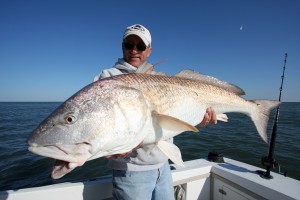 The arrival of the big reds and the start of our new fishing season will happen sometime in April. The full moon of April is the classic time to start fishing for big reds. This is predictable enough that some plan vacation time during the April full moon. Always anxious for their arrival, we start fishing for them earlier each year. When the calendar turns to March, we are thinking drum. We cannot help ourselves but we really should just wait a bit. May is the month that the red drum bite is red hot.
The arrival of the big reds and the start of our new fishing season will happen sometime in April. The full moon of April is the classic time to start fishing for big reds. This is predictable enough that some plan vacation time during the April full moon. Always anxious for their arrival, we start fishing for them earlier each year. When the calendar turns to March, we are thinking drum. We cannot help ourselves but we really should just wait a bit. May is the month that the red drum bite is red hot.
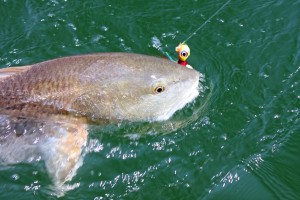 We use three techniques to target these big red drum. Most often, we will anchor in a productive area and fish with natural baits on the bottom with fish-finder rigs. Trolling spoons along the beaches of Virginia’s Eastern Shore and over and around the shoals near the mouth of the Chesapeake Bay can produce trophy-sized red drum. The third technique is to just cruise around and look for schools of drum on the surface. When you see them, a well-cast jig will get pounced on.
We use three techniques to target these big red drum. Most often, we will anchor in a productive area and fish with natural baits on the bottom with fish-finder rigs. Trolling spoons along the beaches of Virginia’s Eastern Shore and over and around the shoals near the mouth of the Chesapeake Bay can produce trophy-sized red drum. The third technique is to just cruise around and look for schools of drum on the surface. When you see them, a well-cast jig will get pounced on.
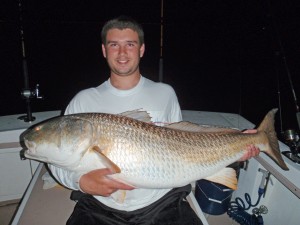 When bait fishing, we will start the season along the beaches and inlets of the Eastern Shore. Fisherman’s and Smith Islands and the inlet in between them, is a prime area. As the water warms, we will fish more off of the beach. Places like Nautilus, 9-Foot, and Latimer Shoals and an area near buoy 10 on the seaside of the high rise area of the Chesapeake Bay Bridge Tunnel are all great areas to soak baits for big red drum. Along the beach, we anchor up near the breakers and cast our baits towards the white water. Anchoring up out on the shoals is a lot less “sporty”. Pick an area near a depth change and cast out a number of baits and wait for the drum to find you. Fish-finder rigs with pyramid sinkers of about 6 ounces and an 8/0 sized
When bait fishing, we will start the season along the beaches and inlets of the Eastern Shore. Fisherman’s and Smith Islands and the inlet in between them, is a prime area. As the water warms, we will fish more off of the beach. Places like Nautilus, 9-Foot, and Latimer Shoals and an area near buoy 10 on the seaside of the high rise area of the Chesapeake Bay Bridge Tunnel are all great areas to soak baits for big red drum. Along the beach, we anchor up near the breakers and cast our baits towards the white water. Anchoring up out on the shoals is a lot less “sporty”. Pick an area near a depth change and cast out a number of baits and wait for the drum to find you. Fish-finder rigs with pyramid sinkers of about 6 ounces and an 8/0 sized 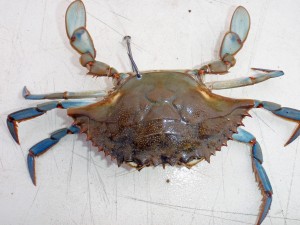 hook work well. Booth J-hooks and circle hooks work. We have placed pop-up satellite tags in 17 large red drum caught on J-hooks including two that were deep hooked. We had no mortalities. Good baits include cut fresh fish (bunker, mullet, spot, croaker), live spot and croaker, and peeler crab. In addition to big red drum, the various sharks and rays living in the area also love to eat these baits. To cut down on unwanted by-catch, whole, live hard crabs make good drum baits. That has become our bait of choice but there are times that a half of a peeler crab or a live croaker will really turn the trick. You can catch drum during the daytime and nighttime while fishing natural bait but typically, it is the nighttime that will be the most productive.
hook work well. Booth J-hooks and circle hooks work. We have placed pop-up satellite tags in 17 large red drum caught on J-hooks including two that were deep hooked. We had no mortalities. Good baits include cut fresh fish (bunker, mullet, spot, croaker), live spot and croaker, and peeler crab. In addition to big red drum, the various sharks and rays living in the area also love to eat these baits. To cut down on unwanted by-catch, whole, live hard crabs make good drum baits. That has become our bait of choice but there are times that a half of a peeler crab or a live croaker will really turn the trick. You can catch drum during the daytime and nighttime while fishing natural bait but typically, it is the nighttime that will be the most productive.
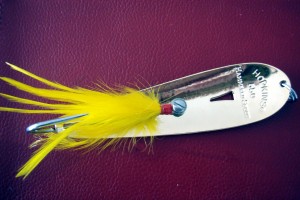 Trolling and sight casting are both daytime techniques. Spoons like the 3 ½ Drone, #19 Pet, and 550 Hopkins are good baits to troll for big reds. Tie them to a leader of about 80-pound test mono about 20 feet in length. Place a 6-8 ounce trolling sinker in between your leader and main line. Slowly troll these spoons around and over the shoals and along the beaches. They should be trolled a long ways behind the boat. In the shallow water, your sinkers will be bouncing along the bottom, creating a commotion, with your shiny spoons fluttering along behind them. Often your bites will be in the blind but keep looking for schools of drum. If you spot them, troll your spoons in front of the schools and be ready for all of your rods to go down.
Trolling and sight casting are both daytime techniques. Spoons like the 3 ½ Drone, #19 Pet, and 550 Hopkins are good baits to troll for big reds. Tie them to a leader of about 80-pound test mono about 20 feet in length. Place a 6-8 ounce trolling sinker in between your leader and main line. Slowly troll these spoons around and over the shoals and along the beaches. They should be trolled a long ways behind the boat. In the shallow water, your sinkers will be bouncing along the bottom, creating a commotion, with your shiny spoons fluttering along behind them. Often your bites will be in the blind but keep looking for schools of drum. If you spot them, troll your spoons in front of the schools and be ready for all of your rods to go down.
 It is a good idea to always have a jig rigged and ready to cast. Drum, cobia, striped bass, and bluefish are likely to be encountered if you spend any time around the oceanfront or in the lower Chesapeake Bay. They all will attack a jig worked past them. This can just be your lucky day or you can actively cruise around looking for schools of red drum. From a distance, they will just look like a color change in the water. After running into them a couple of times, you will know what you are looking for. Sight fishing has been a very productive technique the past few years.
It is a good idea to always have a jig rigged and ready to cast. Drum, cobia, striped bass, and bluefish are likely to be encountered if you spend any time around the oceanfront or in the lower Chesapeake Bay. They all will attack a jig worked past them. This can just be your lucky day or you can actively cruise around looking for schools of red drum. From a distance, they will just look like a color change in the water. After running into them a couple of times, you will know what you are looking for. Sight fishing has been a very productive technique the past few years.

